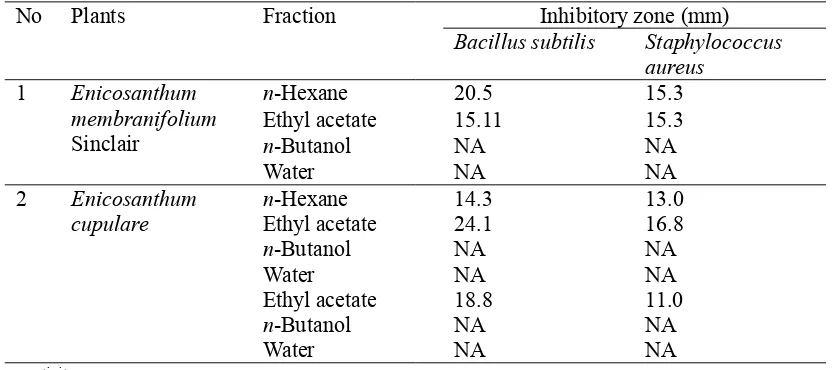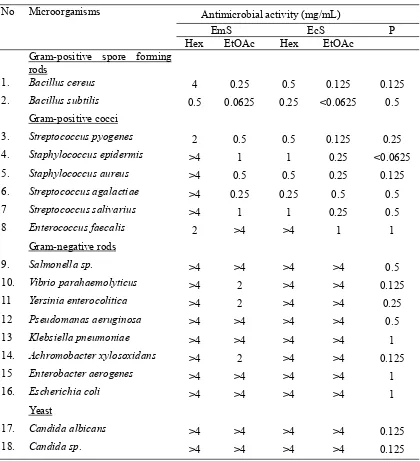STUDY ON ANTI-MICROBIAL PROPERTIES OFEnicosanthum membranifolium SINCLAIR ANDEnicosanthum cupulare(KING) AIRY-SHAW
Mai Efdi1, Mamoru Koketsu2, Kunitomo Watanabe3, Nurainas4
1Department of Chemistry, Faculty of Mathematics and Natural Science, Andalas University 2Division of Instrumental Analysis, Life Science Research Center
3Division of Anaerobe Research Life Science Research Center, Gifu University 4Department of Biology, Faculty of Mathematics and Natural Science, Andalas University
ABSTRACT
n-Hexane and ethyl acetate fractions of methanol extracts of two species of Annonaceae, Enicosanthum membranifolium Sinclair and Enicosanthum cupulare (King) Airy-Shaw, were screened for antimicrobial activity against eighteen bacterial strains using agar dilution method. The ethyl acetate fraction of the two Annonaceae plants showed higher antimicrobial activities than then-hexane fraction. The extracts of the plants tested were significantly more active against gram-positive with minimum inhibitory concentration (MICs) ranging from 0.0625 to 4 mg/mL than against gram negative bacteria (MICs >4 mg/mL).
Keywords:Antibacterial activity; Enicosanthum membranifolium Sinclair; Enicosanthum cupulare (King) Airy-Shaw
INTRODUCTION
Many efforts have been made to discover new antimicrobial compounds from various kinds of sources such as micro-organisms, animals, and plants. Numerous studies have been carried out to extract various natural products for screening antimicrobial activity[1-5]. Systematic screening of them may result in the discovery of novel effective compounds[6]. Annonaceae family is one of the plants which attracted much interest. Annonaceae family is a rich source of bioactive substances. Many species belonging to Annonaceae family produced antimicrobial compounds with structurally diverse. C-Benzylated chalcone was isolated from Ellipeiopsis cherrevensis[7]. Mitrephorone A, mitrephorone B and mitrephorone were isolated from Mitrephora glabra[8]. Reticuline, anonaine, laurelliptine and isoboldine were found in the bark of Annona salzmanii D.C.[9]. Cherimolin and dihydrocherimolin were obtained in Annona cherimolia[10]. Ent-trachyloban-19-oic acid,
ent-kaur-16-en-19-oic acid,
8(14),15-pimaradien-18-oic acid and 7,15-pimaradien-18-oic acid were identified in Mitrephora celebica[11].
Therefore, in order to confirm value of Annonaceae plants four species belonging this family was collected in Rimbo Panti forest;
they are Enichonsanthum membranifolium
Sinclair, Enichonsanthum cupulare (King)
Airy-Shaw. Based on preliminary screening, these species showed antimicrobial activities. As a part of our study on Annonaceae plants grown in West Sumatra, in this paper we wish to report screening of anti-microbial activities ofEnicosanthum membranifoliumSinclair and Enicosanthum cupulare(King) Airy-Shaw.
MATERIALS AND METHODS
Plants Materials and Extract Preparation
Enicosanthum membranifolium Sinclair, Enicosanthum cupulare(King) Airy-Shaw and Polyalthia caulifloravar. desmantha (Hk. f. et Th.) Sinclair used in this study were collected in Rimbo Panti forest, West Sumatra, Indonesia. Voucher specimen are deposited at Herbarium Andalas University (AND), Padang, Indonesia.
and macerated at room temperature in methanol. The extract was subsequently
filtered and concentrated in vacuo. Each
methanol extract of the plants was partitioned successively with n-hexane, ethyl acetate, n-butyl alcohol and water. Then each fraction (n-hexane, ethyl acetate, n-butyl alcohol and water) was evaporated in vacuo and tested for antimicrobial activity.
Antimicrobial Screening
Micro-Organisms
The following strains of microorganisms were used: Bacillus cereus, Bacillus subtilis, Streptococcus pyogenes, Staphylococcus
epidermis, Staphylococcus aureus,
Streptococcus agalactiae, Streptococcus salivarius, Enterococus faecalis, Salmonella sp., Vibrio parahaemolyticus, Yersinia enterocolitica, Pseudomonas aeruginosa,
Klebsiella pneumoniae, Achromobacter
xylosoxidans, Enterobacter aerogenes,
Escherichia coli, Candida albicans and Candida sp.
Preliminary Screening for Antimicrobial Activities
Plate diffusion assay (cup method) was performed for preliminary screening of methanol extracts and four fractions (n-hexane,
EtOAc, n-butanol and water) of
Eniconsanthum membranifolium Sinclair, Enichonsanthum cupulare (King) Airy-Shaw andPolyalthia caulifloravar.desmantha(Hk. f. et Th.) Sinclair. The antimicrobial assay was carried out based on an NCCLS global consensus standard[12]. In this method, Staphylococcus aureus and Bacillus subtilis were used as test organisms. The dried plant
extracts were dissolved in aqueous
dimethylsulfoxide (DMSO) : water (125 : 875) to a final concentration of 10 mg/L. Sterile cups were placed on the surface of agar plates inoculated with a microbial culture and then 200 µL of the solution extracts were dropped into the cups. Each extract was tested in duplicate. Control cup contained 200 µL of sterile 12.5 % aqueous DMSO. Agar plates containing bacteria were incubated at 35°C for 24 h. After incubation, the diameters of growth
measured.
Minimum Inhibitory Concentration (MIC)
In vitro antimicrobial activity was determined by the agar dilution method. The antimicrobial assay was carried out based on an NCCLS global consensus standard[13]. A series of concentrations (4, 2, 1, 0.5, 0.25, 0.125, 0.0625 mg/mL) from extracts were prepared in 1 mL DMSO. Each antimicrobial dilution (0.2 mL) was transferred to a tube containing 19.8 mL of BHI medium to make a 1:10 dilution. Then it was mixed well and poured into a Petri dish. It was allowed to set and dry the surface of the plates. Suspensions of microorganisms were then incubated on the plate containing of antimicrobial compounds at 35°C for 18 h. Control (just containing solvent only) was made with the same ways. Polyphenon-100 (containing epigallocatechin gallate 59.4%, epigallocatechin 11.6%, epicatechin 11.4%, epicatechin gallate 2.1% and gallocatechin gallate 4.3%) as positive control was made in the same ways. The MIC was determined as the lowest dilution which completely prevented microbial growth.
Phytochemical Screening
Identifications of secondary metabolites were carried out on the methanol extract of the plants using chemical method according to the
methods described by Fransworth[14] and
Harbone[15,16].
RESULT AND DISCUSSION
Screening of antimicrobial activity of methanol
extracts of Enicosanthum membranifolium
Sinclair and Enicosanthum cupulare (King) Airy-Shaw againstStaphyllococcus aureusand Bacillus subtilis was carried out using cup method. All of methanol extracts showed activities against the microorganism tested.
Inhibitory zone of Enicosanthum
extracts were tested their antimicrobial activity using cup method against S. aureus and B. subtilis. As the results the n-hexane and ethyl acetate fractions showed activity against microorganism tested (Table 1). The n-hexane and ethyl acetate fractions of each species were necessary to be continued to evaluate their potential as antimicrobial. To study their antimicrobial activities, 18 kinds of strain microorganisms were used.
Table 2 shows the MICs of the extracts tested (range of concentration of crude extracts: 0.0625 to 4 mg/mL) against a range of microorganisms. The extracts of the plant
mainly inhibited against gram-positive
microorganisms. Against bacterial Gram-positive, the activities of ethyl acetate fraction of Enicosanthum membranifolium Sinclair, Enicosanthum cupulare (King) Airy-Shaw and Polyalthia cauliflora var. desmantha Sinclair were stronger than n-hexane fractions. The
n-hexane extract of E. membranifolium was
active against B. subtilis, S. pyogenes and E. faecalis (gram-positive microorganisms) with range of MICs were 0.5 to 2 mg/mL.
The ethyl acetate fraction of this plant was active againstB.cereus,B subtilis,S.pyogenes, S. epidermis, S. aureus, S. agalactiae and S. salivarius (gram-positive microorganisms) with 0.0625 to 1 mg/mL of MICs range. The
n-hexane extract of E. cupulare was active
against B. cereus, B. subtilis, S. pyogenes, S.
epidermis, S. aureus, S. agalactiae and S. salivarius with MICs range were 0.25 to 1 mg/mL. MICs range of the ethyl acetate extracts of this plant against B. cereus, B subtilis,S.pyogenes,S.epidermis,S.aureus,S. agalactiaeandS. salivariuswere <0.0625 to 1
mg/mL. The n-hexane and ethyl acetate
extracts ofP. cauliflora were active againstB. cereus, B. subtilis, S. pyogenes, S. epidermis and S. aureus with range of MICs were 1-2 mg/mL and <0.0625 to 0.25 mg/mL. Most of the extracts showed no inhibitory activity againstSalmonella sp., Yersinia enterocolitica, Achromobacter xylosoxidans, Enterobacter aerogenes, Escherichia coli, Candida albicans and Candida sp (>4 mg/mL). Anti-fungal activity was tested usingCandida albicansand Candida sp, most of the extract showed no significant inhibitory activity (>4 mg/mL).
The freshly leaves of Enicosanthum
membranifolium Sinclair and Enicosanthum cupulare (King) Airy-Shaw were subjected to preliminary phytochemical screening. The results showed the presence of phenolic, steroid, terpenoid and alkaloid in two plant leaves (Table 3). The test for flavonoid, however, showed negative result. The presence of secondary metabolites such as phenolics, steroid, terpenoid and alkaloid in these plants could be responsible for antimicrobial activity, because many compounds from these classes have reported as antimicrobial agents.
Table 1. Antimicrobial Activities ofn-Hexane, Ethyl Acetate,n-Butanol and Water Fractions of Three Annonaceae Species
No Plants Fraction Inhibitory zone (mm)
Bacillus subtilis Staphylococcus aureus
1 Enicosanthum
membranifolium Sinclair
n-Hexane 20.5 15.3
Ethyl acetate 15.11 15.3
n-Butanol NA NA
Water NA NA
2 Enicosanthum
cupulare n-HexaneEthyl acetate 14.324.1 13.016.8
n-Butanol NA NA
Water NA NA
Ethyl acetate 18.8 11.0
n-Butanol NA NA
Water NA NA
Table 2. MIC ofn-Hexane and Ethyl Acetate Fractions ofEnicosanthum membranifoliumSinclair and Enicosanthum cupulareAgainst 18 Kinds of Microorganisms
No Microorganisms Antimicrobial activity (mg/mL)
EmS EcS P
Hex EtOAc Hex EtOAc
Gram-positive spore forming rods
1. Bacillus cereus 4 0.25 0.5 0.125 0.125
2. Bacillus subtilis 0.5 0.0625 0.25 <0.0625 0.5
Gram-positive cocci
3. Streptococcus pyogenes 2 0.5 0.5 0.125 0.25
4. Staphylococcus epidermis >4 1 1 0.25 <0.0625
5. Staphylococcus aureus >4 0.5 0.5 0.25 0.125
6. Streptococcus agalactiae >4 0.25 0.25 0.5 0.5
7 Streptococcus salivarius >4 1 1 0.25 0.5
8 Enterococcus faecalis 2 >4 >4 1 1
Gram-negative rods
9. Salmonella sp. >4 >4 >4 >4 0.5
10. Vibrio parahaemolyticus >4 2 >4 >4 0.125
11 Yersinia enterocolitica >4 2 >4 >4 0.25
12 Pseudomanas aeruginosa >4 >4 >4 >4 0.5
13 Klebsiella pneumoniae >4 >4 >4 >4 1
14. Achromobacter xylosoxidans >4 2 >4 >4 0.125
15 Enterobacter aerogenes >4 >4 >4 >4 1
16. Escherichia coli >4 >4 >4 >4 1
Yeast
17. Candida albicans >4 >4 >4 >4 0.125
18. Candida sp. >4 >4 >4 >4 0.125
EmS:Enicosanthum membranifoliumSinclair; EcS:Enicosanthum cupulare; P: Polyphenon-100 (as positive control)
Table 3. Phytochemical Analysis ofEnicosanthum membranifolium, Enicosanthum cupulare, Polyalthia caulifloravar. desmantha andGoniothalamus tapisMiq
Principles Test applied EmS Plants EcS
Alkaloids Mayer + +
Phenolic
compounds Ferricchloride + +
Flavonoids Mg/HCl -
-Terpenoids/steroids H2SO4-Ac2O + +
CONCLUSION
In conclusion, the three Annonaceae species used in this study exhibited selective antimicrobial activity to varying degrees. They may, therefore, provide new leads in the ongoing search for novel antimicrobial drugs. Bioassay-guided isolation of the antimicrobial active compounds will be made on the active fractions of E. membranifolium Sinclair, E. cupulare (King) Airy-Shaw and Polyalthia cauliflora var. desmantha (Hk. f. et Th.) Sinclair. We also aim to perform chemical characterization of some of the antimicrobially active compounds.
ACKNOWLEDGEMENTS
We thank to Pitra Akhriadi S.Si of herbarium Andalas University (AND) for helping in the collection and identification of the plant materials.
REFERENCES
1. C. M. Chariandy, C. E. Seaforth, R. H. Phelps, G. V. Pollard, B. P. S. Khambay, J. Ethnopharmacol., 64: 265–270, (1999). 2. P. Kloucek, Z. Polesny, B. Svobodova, E.
Vlkova, L. Kokoska, J. Ethnopharmacol, 99: 309–312, (2005).
3. J. B. Sindambiwe, M. Calomme, P. Cos, J. Totté, L. Pieters, A. Vlietinck, D. V.
Berghe, J. Ethnopharmacol, 65: 71–77,
(1999).
4. G. H. Konning, C. Agyare, B. Ennison, Fitoterapia,75: 65–67, (2004).
5. I. Ahmad, Z. Mehmood, F. Mohammad,J.
Ethnopharmacol,62: 183–193, (1998).
6. T. Nitta, T. Arai, H. Takamatsu, Y. Inatomi, H. Murata, M. Iinuma, T. Tanaka, T. Ito, F. Asai, I. Ibrahim, T. Nakanishi, K. Watanabe, J. Health Sci., 48: 273–276, (2002).
7. L. Wirasathien, T. Pengsuparp, M. Moriyasu, K. Kawanishi, R. Suttisri, Arch. Pharmacal. Res.,29: 497-502, (2006). 8. C. Li, D. Lee, T. N. Graf, S. S. Phifer, Y.
Nakanishi, J. P. Burgess, S. Riswan, F. M. Setyowati, A. M. Saribi, D. D. Soejarto, N. R. Farnsworth, J. O. Falkinham, D. J. Kroll, A. D. Kinghorn, M. C. Wani, N. H. Oberlies,Org. Lett.,7: 5709-5712, (2005). 9. M. de Q. Paulo, J. M. Barbosa-Filho, E. O.
Lima, R. F. Maia, de R. Cassia, B. B. C.
Barbosa, M. A. C. Kaplan, J.
Ethnopharmacol,36: 39-41, (1992). 10. D. Cortes, J. L. Rios, A. Villar, S.
Valverde, Tetrahedron Lett., 25: 3199-3202, (1984).
11. J. R. Zgoda-Pols, A. J. Freyer, L. B. Killmer, J. R. Porter,Fitoterapia,73: 434-438, (2002).
12. An NCCLS global consensus standard, Performance standards for antimicrobial
disk susceptibility tests: Approved
standard Eight edition, 2003, 6-11.
13. An NCCLS global consensus standard,
Methods for dilution antimicrobial
susceptibility tests for bacteria that grow aerobically: Approved standard, Sixth edition, 2003, 9-13.
14. N. R. Fransworth,J. Pharm. Sci., 55: 225– 276, (1966).
15. J. B. Harborne, Phytochemical Method. Chapmann and Hall, London, 1973.

